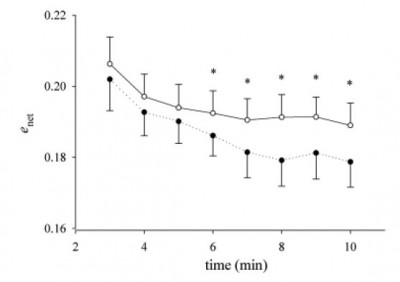THANK YOU FOR VISITING SWEATSCIENCE.COM!
As of September 2017, new Sweat Science columns are being published at www.outsideonline.com/sweatscience. Check out my bestselling new book on the science of endurance, ENDURE: Mind, Body, and the Curiously Elastic Limits of Human Performance, published in February 2018 with a foreword by Malcolm Gladwell.
- Alex Hutchinson (@sweatscience)
***
I wrote a few months ago about an Italian study showing that static stretching hurts cycling performance — that was the first study I’d seen about stretching and cycling, joining a whole bunch of studies showing that stretching hurts speed, power and endurance in running. Now researchers at Cal State Fullerton have backed up that initial result with a slightly different study, published in the Journal of Strength & Conditioning Research, that reaches basically the same conclusion.
The study was very simple: 10 highly trained cyclists (5 men, 5 women) did two 30-minute rides at 65% VO2max pace, while the researchers measured economy (i.e. how much oxygen they needed to maintain the pace), perceived exertion, and heart rate. Before one of the rides, they did a standard 16-minute static stretching routine. Here are the results for oxygen use (squares indicate the non-stretching trial):
 Pretty straightforward: after stretching, it took more oxygen to maintain the same pace. Note that the difference was statistically significant only at the five-minute mark, not for the rest of the data points, indicating that the effect gradually wears off. Perceived exertion was the same in both trials — so the volunteers felt the same, but their bodies were working less efficiently.
Pretty straightforward: after stretching, it took more oxygen to maintain the same pace. Note that the difference was statistically significant only at the five-minute mark, not for the rest of the data points, indicating that the effect gradually wears off. Perceived exertion was the same in both trials — so the volunteers felt the same, but their bodies were working less efficiently.
Why does this happen? The researchers write that the results “may be explained through either muscle mechanics or neural factors or a combination of the two.” Then they spend a few pages going through all the various muscle-related theories and the various brain/nerve-related theories. The short answer is that no one knows. One of the previous neural studies they mentioned was interesting, and I wasn’t familiar with it:
Cramer et al. (4) proposed neural factors, such as decreased muscle activation or altered reflex sensitivity, might be the primary mechanism underlying the stretching-induced decreases in force. After stretching only one leg, they reported the same pattern of stretch-induced decrease in both stretched and un-stretched limbs...
That’s pretty cool! It certainly suggests that, whatever is going on in the muscles, there’s also something going on in the nervous system. Bottom line is simple — and by now, should be no surprise: don’t static stretch before workouts or races. It hinders performance.


 On average, efficiency was about 4% lower after stretching. The time to exhaustion was decreased by 26% after stretching (22:57 vs. 31:12).
On average, efficiency was about 4% lower after stretching. The time to exhaustion was decreased by 26% after stretching (22:57 vs. 31:12). The trend is pretty clear. The age by which 50% of the population died was 73.5 for the general cohort, and 81.5 for the Tour de France riders — who, according to the paper, ride about 30,000 to 35,000 km per year (though I’d be surprised in the riders competing in the 1930s were training as hard as modern riders).
The trend is pretty clear. The age by which 50% of the population died was 73.5 for the general cohort, and 81.5 for the Tour de France riders — who, according to the paper, ride about 30,000 to 35,000 km per year (though I’d be surprised in the riders competing in the 1930s were training as hard as modern riders).